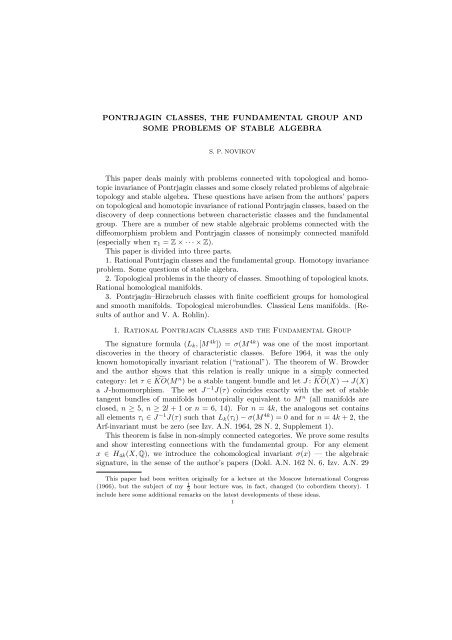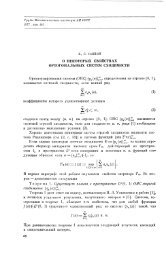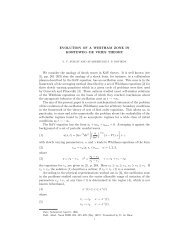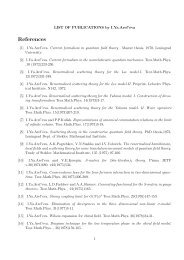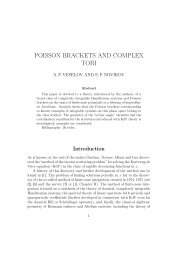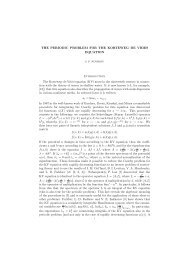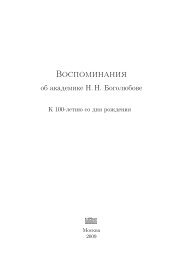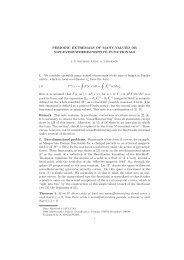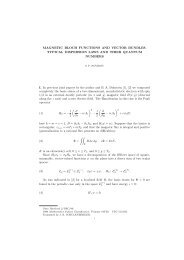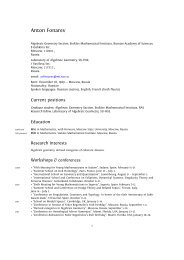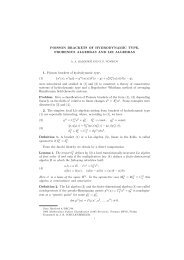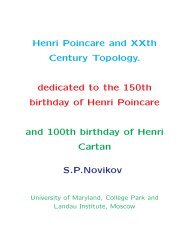Pontryagin classes, the fundamental group and some problems of ...
Pontryagin classes, the fundamental group and some problems of ...
Pontryagin classes, the fundamental group and some problems of ...
You also want an ePaper? Increase the reach of your titles
YUMPU automatically turns print PDFs into web optimized ePapers that Google loves.
PONTRJAGIN CLASSES, THE FUNDAMENTAL GROUP AND<br />
SOME PROBLEMS OF STABLE ALGEBRA<br />
S. P. NOVIKOV<br />
This paper deals mainly with <strong>problems</strong> connected with topological <strong>and</strong> homotopic<br />
invariance <strong>of</strong> Pontrjagin <strong>classes</strong> <strong>and</strong> <strong>some</strong> closely related <strong>problems</strong> <strong>of</strong> algebraic<br />
topology <strong>and</strong> stable algebra. These questions have arisen from <strong>the</strong> authors’ papers<br />
on topological <strong>and</strong> homotopic invariance <strong>of</strong> rational Pontrjagin <strong>classes</strong>, based on <strong>the</strong><br />
discovery <strong>of</strong> deep connections between characteristic <strong>classes</strong> <strong>and</strong> <strong>the</strong> <strong>fundamental</strong><br />
<strong>group</strong>. There are a number <strong>of</strong> new stable algebraic <strong>problems</strong> connected with <strong>the</strong><br />
diffeomorphism problem <strong>and</strong> Pontrjagin <strong>classes</strong> <strong>of</strong> nonsimply connected manifold<br />
(especially when π 1 = Z × · · · × Z).<br />
This paper is divided into three parts.<br />
1. Rational Pontrjagin <strong>classes</strong> <strong>and</strong> <strong>the</strong> <strong>fundamental</strong> <strong>group</strong>. Homotopy invariance<br />
problem. Some questions <strong>of</strong> stable algebra.<br />
2. Topological <strong>problems</strong> in <strong>the</strong> <strong>the</strong>ory <strong>of</strong> <strong>classes</strong>. Smoothing <strong>of</strong> topological knots.<br />
Rational homological manifolds.<br />
3. Pontrjagin–Hirzebruch <strong>classes</strong> with finite coefficient <strong>group</strong>s for homological<br />
<strong>and</strong> smooth manifolds. Topological microbundles. Classical Lens manifolds. (Results<br />
<strong>of</strong> author <strong>and</strong> V. A. Rohlin).<br />
1. Rational Pontrjagin Classes <strong>and</strong> <strong>the</strong> Fundamental Group<br />
The signature formula (L k , [M 4k ]) = σ(M 4k ) was one <strong>of</strong> <strong>the</strong> most important<br />
discoveries in <strong>the</strong> <strong>the</strong>ory <strong>of</strong> characteristic <strong>classes</strong>. Before 1964, it was <strong>the</strong> only<br />
known homotopically invariant relation (“rational”). The <strong>the</strong>orem <strong>of</strong> W. Browder<br />
<strong>and</strong> <strong>the</strong> author shows that this relation is really unique in a simply connected<br />
category: let τ ∈ ˜KO(M n ) be a stable tangent bundle <strong>and</strong> let J : ˜KO(X) → J(X)<br />
a J-homomorphism. The set J −1 J(τ) coincides exactly with <strong>the</strong> set <strong>of</strong> stable<br />
tangent bundles <strong>of</strong> manifolds homotopically equivalent to M n (all manifolds are<br />
closed, n ≥ 5, n ≥ 2l + 1 or n = 6, 14). For n = 4k, <strong>the</strong> analogous set contains<br />
all elements τ i ∈ J −1 J(τ) such that L k (τ i ) − σ(M 4k ) = 0 <strong>and</strong> for n = 4k + 2, <strong>the</strong><br />
Arf-invariant must be zero (see Izv. A.N. 1964, 28 N. 2, Supplement 1).<br />
This <strong>the</strong>orem is false in non-simply connected categories. We prove <strong>some</strong> results<br />
<strong>and</strong> show interesting connections with <strong>the</strong> <strong>fundamental</strong> <strong>group</strong>. For any element<br />
x ∈ H 4k (X, Q), we introduce <strong>the</strong> cohomological invariant σ(x) — <strong>the</strong> algebraic<br />
signature, in <strong>the</strong> sense <strong>of</strong> <strong>the</strong> author’s papers (Dokl. A.N. 162 N. 6, Izv. A.N. 29<br />
This paper had been written originally for a lecture at <strong>the</strong> Moscow International Congress<br />
(1966), but <strong>the</strong> subject <strong>of</strong> my 1 hour lecture was, in fact, changed (to cobordism <strong>the</strong>ory). I<br />
2<br />
include here <strong>some</strong> additional remarks on <strong>the</strong> latest developments <strong>of</strong> <strong>the</strong>se ideas.<br />
1
2 S. P. NOVIKOV<br />
N. 6). Let z ∈ H 4k (M n+4k , Q) <strong>and</strong> Dz = y 1 ◦· · ·◦y n , (D denotes Poincaré duality).<br />
We define a covering P z : M z → M n+4k depending on <strong>the</strong> element z: <strong>the</strong> sub<strong>group</strong><br />
Im P z∗ ⊂ π 1 (M n+4k ) contains all γ ∈ π 1 such that (γ, y i ) = 0, i = 1, . . . , n. There<br />
is one “canonical” element ẑ ∈ H 4k ( ˆM z ) (see Izv. A.N. 29, N. 6). Its definition is<br />
purely homotopic.<br />
Theorem 1 (Author, DAN 162 N. 6, 163 N. 2; Izv. A.N. 29, N. 6, 30 N. 1). If<br />
one <strong>of</strong> <strong>the</strong> conditions 1, 2, 2 ′ , 3 holds, <strong>the</strong>n <strong>the</strong> “non-simply connected signature<br />
formula” (L k (M n+4k ), z) = σ(ẑ), ẑ ∈ H 4k ( ˆM z ) is true.<br />
1. n = 1.<br />
2. n = 2 <strong>and</strong> rk[H 2k+1 ( ˆM z , Q)] < ∞.<br />
2 ′ . n = 2, <strong>and</strong> <strong>the</strong> intersection index on <strong>the</strong> <strong>group</strong> H 2k+1 ( ˆM z , Q) is identically<br />
zero.<br />
3. n ≥ 1 <strong>and</strong> M n+4k is homotopically equivalent to a fiber bundle with base<br />
(torus) T n <strong>and</strong> fiber-closed manifold M 4k .<br />
Corollary 1. L k (M 4k+1 ) is a homotopy invariant.<br />
Corollary 2. For all k, p k (M q ) = 0 if M q has <strong>the</strong> homotopy type <strong>of</strong> <strong>the</strong> torus T q .<br />
(From K-<strong>the</strong>ory <strong>and</strong> Adam’s results, we may now deduce that all homotopy tori<br />
are stably parallelizable.)<br />
Many examples show that for n ≥ 2, this simple form <strong>of</strong> <strong>the</strong> nonsimply connected<br />
signature formula is false in general (Izv. A.N. 29 N. 6, Example 2).<br />
We have, however, <strong>the</strong> following important<br />
Theorem 2 (Rohlin, Izv. A.N. 30 N. 3). The scalar product (L k (M 4k+2 ), z) is a<br />
homotopy invariant if Dz = y 1 · y 2 .<br />
Rohlin’s pro<strong>of</strong> is non-constructive (except <strong>the</strong> case <strong>of</strong> part 2 <strong>of</strong> my earlier <strong>the</strong>orem).<br />
The problem <strong>of</strong> calculating <strong>the</strong> number (L k , z) is not solved in general<br />
for n = 2, Dz = y 1 , . . . , y n , except <strong>the</strong> special case <strong>of</strong> Th. 1, part 2. It leads<br />
to interesting <strong>problems</strong> <strong>of</strong> stable algebra. Let ˜J(T n ) be a reduced J-functor <strong>and</strong><br />
let τ ∈ J −1 (0). We apply <strong>the</strong> construction <strong>of</strong> Browder <strong>and</strong> myself <strong>and</strong> obtain a<br />
manifold M n <strong>and</strong> a map f : M n → T n <strong>of</strong> degree 1 such that f ∗ τ ∈ ˜KO(M n ) is<br />
<strong>the</strong> stable tangent bundle <strong>and</strong> ker f ∗<br />
(πi) = 0, i < l, n = 2l. Consider <strong>the</strong> Z(π)-<br />
module N = ker f (π l)<br />
∗ , π = Z × · · · × Z. It has a “unimodular, equivariant <strong>and</strong><br />
compact” scalar product h: N −→ ≈ Hom C (N, Z) which is symmetric for l = 2q <strong>and</strong><br />
skew-symmetric for l = 2q + 1; N is stable free (see Izv. A.N. 30 N. 1). The<br />
pair (N, h) is trivial iff N = F 1 + F 2 , <strong>and</strong> (F 1 , hF 1 ) = (F 2 , hF 2 ) = 0. We have<br />
a sum (N 1 , h 1 ) ⊕ (N 2 , h 2 ) <strong>and</strong> Gro<strong>the</strong>ndieck <strong>group</strong>s A(π), B(π) (symmetric <strong>and</strong><br />
skew-symmetric cases). We may deduce non constructively from Corollary 2:<br />
Theorem 3. For π = Z × Z, <strong>the</strong> <strong>group</strong> B(π) is non-trivial. (The <strong>group</strong> A(π) is<br />
non-trivial also for π = 0 because <strong>the</strong> usual signature is <strong>the</strong> stable invariant.)<br />
Let π be any <strong>group</strong> <strong>and</strong> let A(π), B(π) be <strong>the</strong> analogous Gro<strong>the</strong>ndieck <strong>group</strong>s<br />
<strong>of</strong> free modules with scalar product (symmetric or skew-symmetric) with <strong>some</strong>
PONTRJAGIN CLASSES 3<br />
“Poincaré duality” restrictions, π ∗∗ = Hom(Hom(π, Z), Z). We can deduce from<br />
Corollary 2 <strong>the</strong> following important fact:<br />
Statement. There are nontrivial homomorphisms ∆ i j , j = 1, 2, i ≥ 0,<br />
∆ i 1 : A(π) → Λ 4i π ∗∗ ,<br />
∆ i 2 : B(π) → Λ 4i+2 π ∗∗<br />
(Λ k π ∗∗ are exterior powers <strong>of</strong> Z-modules). ∆ 0 1 is <strong>the</strong> usual signature <strong>of</strong> <strong>the</strong> Z-module<br />
N ⊗ Z(π) Z with induced symmetric scalar product (Note: 0 → Z 0 (π) → Z(π) ɛ −→ Z).<br />
∆ i j are “higher signatures” in <strong>some</strong> sense. They must be such that in <strong>the</strong> geometric<br />
situation ∆ k j (N, h) is equal to <strong>the</strong> dual Pontrjagin–Hirzebruch class DL k(M n ) =<br />
DL k (τ) ∈ H n−4k (M n ), τ ∈ J −1 (0) ⊂ ˜KO(T n ). It is ano<strong>the</strong>r important case <strong>of</strong><br />
“non-simply connected Hirzebruch formula”.<br />
Problem. Define algebraically <strong>the</strong> “higher signatures” ∆ i j .<br />
This algebraic problem is closely connected with <strong>the</strong> following general topological<br />
problem:<br />
Problem. Let Dz = y 1 , . . . , y n , y i ∈ H 1 (M). Is <strong>the</strong> scalar product (L k , z) a homotopy<br />
invariant How can it be calculated<br />
The functors A(π), B(π) are interesting also for o<strong>the</strong>r <strong>group</strong>s. They have an<br />
involution α: A(π) → A(π), α: B(π) → B(π), such that α(N, h) = (N, −h). Especially<br />
interesting in topology are <strong>the</strong> <strong>group</strong>s A α (π) = A(π)/{x + α(x)} <strong>and</strong><br />
B α (π) = B(π)/{x + α(x)} <strong>and</strong> <strong>the</strong> torsion <strong>group</strong>s tor A(π), tor B(π) [for π = 0,<br />
α(x) = −x]. The <strong>group</strong>s A α (π), B α (π) are nontrivial for π = Z p (e.g. p = 5), as<br />
follows from simple homotopy <strong>the</strong>ory toge<strong>the</strong>r with Atiyah’s <strong>the</strong>orem (classical lens<br />
manifolds are h-cobordant iff <strong>the</strong>y are diffeomorphic) <strong>and</strong> my constructions in <strong>the</strong><br />
diffeomorphism problem. This statement is also non constructive.<br />
There are also o<strong>the</strong>r algebraic <strong>and</strong> topological <strong>problems</strong> connected with <strong>the</strong>se <strong>and</strong><br />
analogous functors. For example, we have <strong>the</strong> important fact: a) let f : M1 2n → M2<br />
2n<br />
be a map <strong>of</strong> degree 1 <strong>and</strong> let ker f (π i)<br />
∗ = 0, i < n. If <strong>the</strong> map f is “tangential”<br />
(such that f ∗ τ(M 2 ) = τ(M 1 ); τ denotes <strong>the</strong> stable tangent bundle), <strong>the</strong>n <strong>the</strong><br />
Z(π 1 )-module N = ker f (π n)<br />
∗ with natural scalar product represents <strong>the</strong> element<br />
x(f) ∈ A(π 1 ) for n = 2l <strong>and</strong> x(f) ∈ B(π 1 ) for n = 2l + 1 <strong>and</strong> is such that<br />
x(f) ∈ tor A(π 1 ) or tor B(π 1 ). The correspondence f ↦→ x(f) determines canonical<br />
maps Π(M2 2n 2n<br />
)/ ˜J(M 2 ) −→ x A(π 1 ) for n = 2l, Π(M2 2n 2n<br />
)/ ˜J(M 2 ) −→ x B(π 1 ) for n =<br />
2l + 1. (Π(M n ) is a finite part <strong>of</strong> π N+n (T N ) where T is <strong>the</strong> Thom complex <strong>of</strong> <strong>the</strong><br />
N-dimensional normal SO-bundle) such that x(a + b − c) = x(a) + x(b) + α · x(c).<br />
b) Let W 2n be a manifold with two boundaries M 1 , M 2 <strong>and</strong> tangential retractions<br />
r i : W 2n → M i . Then <strong>the</strong> obstruction to <strong>the</strong> diffeomorphism between M 1 <strong>and</strong> M 2<br />
lies in <strong>the</strong> <strong>group</strong>s A α (π i ) (n = 2l) <strong>and</strong> B α (π 1 ) (n = 2l + 1) or <strong>some</strong> <strong>of</strong> <strong>the</strong>ir factor<br />
<strong>group</strong>s.<br />
We have here <strong>the</strong> important conjecture:<br />
Conjecture. If <strong>the</strong> higher signatures ∆ i j are complete invariants for <strong>the</strong> <strong>group</strong>s A(π 1)<br />
<strong>and</strong> B(π 1 ) (modulo finite <strong>group</strong>s), <strong>the</strong>n <strong>the</strong> number <strong>of</strong> manifolds {M i } as above,
4 S. P. NOVIKOV<br />
M i ∪M j := ∂Wij<br />
2n is finite (up to diffeomorphism homotopic to r −1<br />
i ◦r j : M i → M j )<br />
if <strong>and</strong> only if <strong>the</strong> natural maps Λ 2n−4k π1<br />
∗ = Λ 2n−4k H 1 (M i ) → H 2n−4k (M i ) are<br />
monomorphic for all k.<br />
(I can prove this in <strong>the</strong> case M i ∼ T 2n−1 , dim M i = 2n − 1, n ≥ 3.)<br />
Remark. Very recently, Shaneson proved nonconstructively (he used different terminology)<br />
that “higher signatures” are complete invariants (modulo finite <strong>group</strong>s)<br />
for obstructions to surgeries, <strong>and</strong> <strong>the</strong>refore for Hermitian <strong>and</strong> skew Hermitian integral,<br />
even, unimodular quadratic forms over free abelian <strong>fundamental</strong> <strong>group</strong>s<br />
(Bull. A. M. S., May 1968). The algebraic definitions are unknown! Wall, Hsiang<br />
<strong>and</strong> Shaneson deduced from this <strong>the</strong> important <strong>the</strong>orem that <strong>the</strong> number <strong>of</strong> n-<br />
dimensional homotopy tori (P L or smooth) is finite, n ≠ 4. This fact depends on<br />
<strong>the</strong> “non simply connected Hirzebruch formula” in <strong>the</strong> same way that Milnor’s classical<br />
<strong>the</strong>orem (Θ 4k−1 (∂π) is a finite <strong>group</strong>) does on <strong>the</strong> usual Hirzebruch formula.<br />
R. Kirby found remarkable applications <strong>of</strong> homotopy tori to purely continuous<br />
topology (Annulus Conjecture), developed now by Kirby <strong>and</strong> Siebenmann, Lash<strong>of</strong><br />
<strong>and</strong> Ro<strong>the</strong>nberg. The base <strong>of</strong> his approach is also toral open subsets in <strong>the</strong> “etale<br />
topology”.<br />
2. Topological Problems in <strong>the</strong> Theory <strong>of</strong> Characteristic Classes<br />
I will not formulate here <strong>the</strong> corollaries <strong>of</strong> <strong>the</strong> topological invariance <strong>of</strong> <strong>the</strong> rational<br />
Pontrjagin <strong>classes</strong> (<strong>the</strong>y may be found for example in my paper Izv. A.N. 1966,<br />
30 N. 1, Introduction). I had always considered modern (1966) ”topological invariance<br />
<strong>problems</strong>” (Pontrjagin <strong>classes</strong>, simple homotopy type) from <strong>the</strong> general point<br />
<strong>of</strong> view: All earlier “topological invariance” <strong>the</strong>orems (homology, Stiefel–Whitney<br />
<strong>classes</strong>) state, in fact, that <strong>some</strong> invariants are homotopy invariants. All “negative”<br />
results state, in fact, that <strong>some</strong> invariants are not combinatorial invariants (most<br />
important are Milnor’s results: differentiable structure, stable tangent bundle <strong>and</strong><br />
also integral Pontrjagin <strong>classes</strong> are not combinatorially <strong>and</strong> topologically invariant).<br />
It was well known that rational Pontrjagin <strong>classes</strong> (<strong>and</strong> also Reidemeister–Whitehead<br />
torsion) are combinatorial, but not homotopy, invariants. What properties <strong>of</strong><br />
“continuous homeomorphisms” can be used for studying topological invariants algebraically<br />
My approach to this problem is based on <strong>the</strong> study <strong>of</strong> “toral” open nonsimply<br />
connected subsets <strong>and</strong> <strong>the</strong>ir coverings in an open manifold W homeomorphic to<br />
M q × R n . These open “toral” subsets in <strong>the</strong> “etale” topology are very important in<br />
<strong>the</strong> homeomorphism <strong>problems</strong>. It is a trivial corollary <strong>of</strong> previous papers that for<br />
topological invariance <strong>of</strong> all rational Pontrjagin <strong>classes</strong> it is sufficient to prove <strong>the</strong><br />
formula (L k (W ), [M 4k ]) = σ(M 4k ) (W is homeomorphic to M 4k × R n ) for simply<br />
connected manifolds M 4k (or even just for M 4k = S 4k ).<br />
The main idea <strong>of</strong> <strong>the</strong> pro<strong>of</strong> is to find a sequence <strong>of</strong> non simply connected interpolating<br />
manifolds (open <strong>and</strong> closed) with special properties: we first consider a<br />
subset W 1 ⊂ W homeomorphic to M 4k × T n−1 × R (because T n−1 × R ⊂ R n ) <strong>and</strong><br />
prove that W 1 is diffeomorphic to V 1 × R if π 1 (M 4k ) = 0 or ˜K 0 (π 1 × Z × · · · × Z) =
PONTRJAGIN CLASSES 5<br />
˜K 0 (π 1 (W )) = 0. The pair (W 1 , V 1 ) is <strong>the</strong> first <strong>and</strong> main one in <strong>the</strong> sequence <strong>of</strong> our<br />
manifolds, because L k (V 1 ) = L k (W 1 ) <strong>and</strong> we can apply to V 1 <strong>the</strong> purely homotopic<br />
“non simply connected signature formula” (Theorem 1, part 3). This gives us <strong>the</strong><br />
results: (L k (W ), [M 4k ]) = σ(M 4k ). But our process gives, in fact, a stronger result.<br />
Theorem 4. Let V 1 be homotopically equivalent to M q × T n−1 , q ≥ 5, <strong>and</strong> let<br />
˜K 0 (π 1 × Z × · · · × Z) = 0 (n − 2 times), π 1 = π 1 (M q ). The covering ˆV 1 → V 1<br />
homotopically equivalent to M q (with monodromy <strong>group</strong> Z×· · ·×Z) is diffeomorphic<br />
to Ṽ × Rn−1 (see Izv. A.N. 30 N. 1, Theorem 5 <strong>and</strong> Supplement 2).<br />
I do not know any pro<strong>of</strong> <strong>of</strong> topological invariance <strong>of</strong> <strong>classes</strong> without “toral”<br />
interpolating manifolds. However, <strong>the</strong> problem seems very far (formally) from <strong>the</strong><br />
<strong>fundamental</strong> <strong>group</strong>. I also do not know whe<strong>the</strong>r <strong>the</strong> condition ˜K 0 (π 1 ×Z×· · ·×Z) =<br />
0 is only technical in <strong>the</strong> <strong>problems</strong> connected with M q × R n .<br />
We use here essentially (for technical purposes) a non-simply connected generalization<br />
<strong>of</strong> Browder’s recent <strong>the</strong>orem: if W n+1 is “like” M n × R (M n is closed,<br />
n ≥ 5) <strong>and</strong> ˜K 0 (π 1 ) = 0, <strong>the</strong>n W n+1 is diffeomorphic to V × R) (see W. Browder,<br />
Cambr. Phil. Soc. 1965 for π 1 = 0 <strong>and</strong> <strong>the</strong> author, Izv. A.N. 1966, 30 N. 1<br />
for π 1 ≠ 0). I remark here that <strong>the</strong> last generalization <strong>of</strong> Browder’s <strong>the</strong>orem itself<br />
(<strong>and</strong> also <strong>the</strong> generalization <strong>of</strong> Browder, Levine <strong>and</strong> Livesay’s <strong>the</strong>orem about<br />
<strong>the</strong> boundary for open manifolds) was found independently by L. C. Siebenman;<br />
namely, he found <strong>the</strong> condition ˜K 0 (π 1 ) = 0 in <strong>the</strong>se <strong>problems</strong>, on <strong>the</strong> basis <strong>of</strong><br />
Wall’s idea in ano<strong>the</strong>r problem (“direct summ<strong>and</strong>s” <strong>of</strong> <strong>the</strong> homotopy-finite complexes.<br />
Annals <strong>of</strong> Math. 1965). These ideas were developed recently by V. L. Golo<br />
who found here a “Poincaré duality law”, which gives very strong restrictions on <strong>the</strong><br />
“geometrically realizable” elements in ˜K 0 (π), <strong>and</strong> constructed nontrivial geometric<br />
examples for π = Z p (Doklady 1966). He uses here <strong>some</strong> results <strong>of</strong> Kummer <strong>the</strong>ory<br />
reformulated in terms <strong>of</strong> ˜K0 (π). Soon after my papers (Dokl. A.N. 1965, N. 6;<br />
163 N. 2) Siebenmann developed <strong>some</strong>what <strong>the</strong> construction <strong>of</strong> a sequence <strong>of</strong> nonsimply<br />
connected interpolating manifold <strong>and</strong> proved <strong>the</strong> “splitting <strong>the</strong>orem”: let<br />
˜K 0 (π 1 × Z × · · · × Z) = 0, q ≥ 5, n ≥ 1, π 1 = π 1 (M q ). Then, if W is homeomorphic<br />
to M q × R n , M q closed, it is diffeomorphic to V × R n . 1 Interesting results were<br />
obtained by Sullivan <strong>and</strong> Wagoner in application <strong>of</strong> this result to <strong>the</strong> Hauptvermutung<br />
(Bul., AMS, 1967). In 1967, Sullivan, Lash<strong>of</strong> <strong>and</strong> Ro<strong>the</strong>nberg proved <strong>the</strong><br />
Hauptvermutung for almost all manifolds with π 1 = 0.<br />
Let me give ano<strong>the</strong>r example to illustrate <strong>the</strong> usefulness <strong>of</strong> considering nonsimply<br />
connected open <strong>and</strong> closed submanifolds in purely topological <strong>problems</strong>.<br />
Let S n ⊂ S n+2 be a locally flat topological imbedding <strong>and</strong> let n ≥ 5.<br />
Theorem 5. All such imbeddings S n ⊂ S n+2 are topologically equivalent to differentiable<br />
imbeddings in <strong>some</strong> differentiable structure on S n (from Θ n (∂π); see Izv.<br />
A.N. 30 N. 1, Theorem 6).<br />
1 This <strong>the</strong>orem is a direct corollary <strong>of</strong> Theorem 4 applied to <strong>the</strong> “toral” subset M ×T n−1 ×R ⊂<br />
W only for n ≥ q because we have <strong>the</strong> immersion V × R n → W by Theorem 4.
6 S. P. NOVIKOV<br />
The pro<strong>of</strong> <strong>of</strong> this <strong>the</strong>orem uses essentially open sets U i ⊂ S n <strong>and</strong> W i = U i − S n<br />
with π 1 (W 1 ) = Z, <strong>the</strong> sequence <strong>of</strong> which is “like” S n × S 1 × R.<br />
My first approach to <strong>the</strong> topological <strong>problems</strong> connected with rational Pontrjagin<br />
<strong>classes</strong> contains ano<strong>the</strong>r idea (from <strong>the</strong> technical point <strong>of</strong> view) in <strong>the</strong> study<br />
<strong>of</strong> open manifolds homeomorphic to M 4k × R n <strong>and</strong> M 4k × T n−1 × R (see Dokl.<br />
A.N. 162 N. 6, Izv. A.N. 29 N. 6). It had given me <strong>the</strong> first nontrivial results in<br />
<strong>the</strong>se <strong>problems</strong> (for example, <strong>the</strong> first negative solution <strong>of</strong> <strong>the</strong> Hurewicz problem<br />
about <strong>the</strong> homeomorphism <strong>and</strong> homotopy type <strong>of</strong> closed simply connected manifolds).<br />
This idea is based also on <strong>the</strong> <strong>fundamental</strong> <strong>group</strong> <strong>and</strong> coverings, but does<br />
not use <strong>the</strong> specific differentially-topological technique <strong>of</strong> <strong>the</strong> author <strong>and</strong> Browder<br />
(<strong>and</strong> its generalizations). The method <strong>of</strong> <strong>the</strong>se papers is purely homological (for<br />
manifolds over Q). But <strong>the</strong>re are many difficulties here (not only technical ones) in<br />
codimensions greater <strong>the</strong>n two. It would be very interesting to develop this method.<br />
Perhaps this problem is connected closely with <strong>the</strong> homotopy <strong>problems</strong> <strong>of</strong> <strong>the</strong> first<br />
part <strong>of</strong> our paper, because <strong>the</strong> parts 1 <strong>and</strong> 2 <strong>of</strong> Theorem 1 were obtained by this<br />
method.<br />
3. Pontrjagin–Hirzebruch Classes over <strong>the</strong> Finite Coefficient<br />
Groups<br />
We consider now <strong>the</strong> coefficient <strong>group</strong> Z m <strong>and</strong> <strong>classes</strong> p k ∈ H 4k (M, Z m ). Many<br />
homotopic invariance relations are known here. All <strong>of</strong> <strong>the</strong>m are connected with<br />
J-functors <strong>and</strong> cohomological operations in <strong>some</strong> sense (Thom, Wu, Atiyah, Hirzebruch).<br />
However <strong>the</strong> class p 1 is not homotopically invariant for 5-manifolds (<strong>the</strong><br />
rational class p 1 (M 5 ) is homotopically invariant). This may be seen with <strong>the</strong> classical<br />
lens manifolds M 2l+1 = L 2l+1<br />
p ; (g 0 , . . . . , g l ), g i ≠ 0 (modulo p). The complete<br />
homotopy invariant here is q = ∏ i g i up to multiplication on λ l+1 ≢ 0 (mod p),<br />
p k = (∑ )<br />
i q2k i x 2k , x ∈ H 2 (L, Z).<br />
As previous (“rational”) results had shown, it is useful for invariance <strong>problems</strong> to<br />
give a “signature” definition <strong>of</strong> <strong>classes</strong> (modulo p) like <strong>the</strong> Thom–Rohlin–Schwartz<br />
definition <strong>of</strong> rational <strong>classes</strong>.<br />
The problem <strong>of</strong> finding such a definition was solved by <strong>the</strong> author <strong>and</strong> V. A. Rohlin.<br />
We shall give a definition <strong>of</strong> <strong>classes</strong> δ k · L k (mod m) for Q m -homological manifolds<br />
(Q m is <strong>the</strong> ring <strong>of</strong> rationals with denominators relatively prime to m), δ k =<br />
∏<br />
i≤4k |π N+i(S N )| 2 .<br />
Remark. We can define also <strong>the</strong> <strong>classes</strong> µ k·L k for Q m -manifolds, µ k = ∏ p≥2 p[(2k−1)/(p−1)] ,<br />
by using more complicated arguments, connected with <strong>the</strong> problem <strong>of</strong> realization <strong>of</strong><br />
<strong>the</strong> homology class by a submanifold with normal SO-bundle: <strong>the</strong> universal multiple<br />
α i in this problem (such that α i z is realizable for all z ∈ H i (M n , Z), n > 2i) is<br />
equal to ∏ p>2 p[(i−1)/(2p−2)] , <strong>and</strong> α 4k = µ k ) (Dokl. A.N., 1960, v. 132 N. 5).<br />
The idea <strong>of</strong> <strong>the</strong> definition <strong>of</strong> Rohlin <strong>and</strong> myself is this: we realize <strong>the</strong> homology<br />
class Z (mod m) by a regular map f : V 4k → M <strong>of</strong> a manifold with boundary<br />
∂V 4k = mW = W ∪· · ·∪W (m times), such that <strong>the</strong> image <strong>of</strong> ∂V 4k is diffeomorphic<br />
to W <strong>and</strong> f on each component <strong>of</strong> ∂V 4k is a diffeomorphism. The normal bundle <strong>of</strong>
PONTRJAGIN CLASSES 7<br />
f may be trivial (first variant) or an SO-bundle (second variant). We consider <strong>the</strong><br />
natural quadratic form (possibly degenerate) on H 2k (V 4k , Q) or H 2k (V 4k , ∂V ; Q)<br />
<strong>and</strong> its signature σ(V 4k ).<br />
Our definition is: (L k ; Z) = σ(V 4k ) mod m (in <strong>the</strong> first variant). This definition<br />
is correct. We use here essentially results <strong>of</strong> cobordism <strong>the</strong>ory (all torsions have<br />
order 2) <strong>and</strong> <strong>the</strong> next lemma: let V1 4k , V2 4k be manifolds having <strong>the</strong> same closed<br />
component in <strong>the</strong>ir boundaries W ⊂ V1 4k , W ⊂ V2 4k ; <strong>the</strong>n <strong>the</strong> signature is an<br />
additive invariant: σ(V1 4k ∪ W V2 4k ) = σ(V1 4k )+σ(V2 4k ). If ∂V = mW , <strong>the</strong>n 2W ∼ 0<br />
in Ω SO (or W ∼ 0 in Ω SO if m = 2l + 1). 2<br />
Thus 2W = ∂ ¯V <strong>and</strong> σ(V 4k ∪ 2W ¯V ∪2W · · · ∪ 2W ¯V ) = σ(V 4k ) modulo m/2 for<br />
any ¯V , <strong>and</strong> we can apply to <strong>the</strong> manifold (V 4k ∪ 2W ¯V ∪2W · · · ∪ 2W ¯V ) (m/2 times)<br />
<strong>the</strong> usual Hirzebruch formula.<br />
Rohlin <strong>and</strong> I have proved <strong>the</strong> following <strong>the</strong>orems A <strong>and</strong> B.<br />
Theorem A. Let M 4k+1 be a Q m -homological manifold <strong>and</strong> z ∈ H 4k (M 4k+1 , Q)<br />
a homology class such that (βz) · (βz) = 0, β = Bokšteĭn coboundary. Then <strong>the</strong><br />
scalar product (L k , Z) mod m is topologically invariant.<br />
The pro<strong>of</strong> <strong>of</strong> <strong>the</strong>orem A is <strong>the</strong> development <strong>of</strong> purely homological papers (Novikov,<br />
DAN 126 N. 6; Izv. 29 N. 6 <strong>and</strong> Rohlin, Izv. 30 N. 3). The pro<strong>of</strong> <strong>of</strong> <strong>the</strong>orem B is<br />
differential-topological.<br />
Problem. Is this scalar product homotopically invariant This problem seems to<br />
be connected with “coverings with fixed points”.<br />
Theorem B. All <strong>classes</strong> δ k L k <strong>of</strong> smooth manifolds are topological invariants.<br />
We have now a number <strong>of</strong> corollaries:<br />
Corollary A. There are universal numbers λ k ≠ 0 such that for any manifold<br />
M, complex X <strong>and</strong> map f : X → M (dim X ≤ k) <strong>the</strong> element λ k f ∗ τ ∈ ˜KO(X) is<br />
a topological invariant <strong>of</strong> M (τ is <strong>the</strong> stable tangent bundle <strong>of</strong> M). For example,<br />
λ n τ ∈ ˜KO(M n ) is a topological invariant (X = M, f = 1). The number λ 5 is<br />
equal to 2 h · 3 k (possibly h = k = 0). We consider <strong>the</strong> classical lens 5-manifolds<br />
with π 1 = Z 5 . All <strong>of</strong> <strong>the</strong>m are homotopically equivalent, because <strong>the</strong> equation λ = µ 3<br />
(mod 5) always has a solution. But <strong>the</strong>y may have different <strong>classes</strong> p 1 .<br />
Corollary B. There are topologically nonequivalent classical lens manifolds with<br />
π 1 = Z 5 in dimension 5 (or <strong>the</strong> unitary transformation <strong>group</strong>s A 5 = 1), which are<br />
homotopy equivalent.<br />
Corollary C. For almost all prime p (except a finite number, depending upon <strong>the</strong><br />
dimension) <strong>the</strong> tangential homotopy type <strong>of</strong> lens manifolds is a topological invariant.<br />
Corollary D. The Milnor map j : ˜KO(X) → ˜K top (X) for any complex X, dim X ≤<br />
k, is such that Ker j is a periodic <strong>group</strong> with period λ k .<br />
2 The Cobordism <strong>the</strong>ory (mod p) <strong>and</strong> its topological applications were pushed very far by<br />
D. Sullivan in 1967 in his paper about <strong>the</strong> space F/P L <strong>and</strong> <strong>the</strong> Hauptvermutung. This <strong>the</strong>ory is<br />
based on manifolds W with ∂W = pV , as is our definition <strong>of</strong> p k modulo p.


